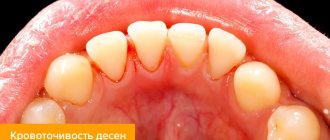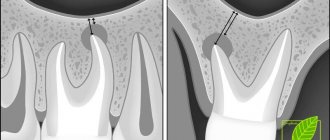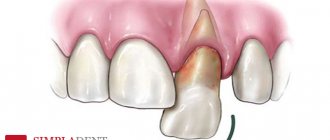If the neck of a tooth is exposed (also called a wedge-shaped defect or recession), you should contact a qualified dentist. In the absence of proper treatment, not only the development of caries and oral diseases can occur, but also the destruction of enamel, increased tooth sensitivity, and inflammation of the gums. At an advanced stage of the problem, the likelihood of exposure of the roots increases, and a person may lose a tooth.
Advantages of treatment of exposed tooth neck at the Academy Dent clinic
During various procedures, Dr. Sadov’s clinic uses modern anesthetic methods. The problem of each patient is carefully studied, qualified doctors prescribe step-by-step treatment, which will use innovative technologies and medications.
Medical instruments are cleaned and sterilized using an autoclave. It is also mandatory to carry out azopyram (checks whether blood remains on the instrument) and phenolphthalein (checks whether alkaline components remain on the instrument) tests.
The clinic’s specialists have extensive experience and regularly attend seminars and conferences to improve their skills (at least 4-6 times every 12 months). Using the latest therapeutic and surgical techniques, doctors prevent tooth decay and reduce the risk of bone and soft tissue diseases.
Exposure of the cervix causes severe pain
Our teeth consist of a crown part, which rises above the gum, as well as a neck and root system, which are hidden by soft and hard tissues. The neck of the tooth is the area between the crown and the roots; in fact, it is the transitional part from the crown to the root. On top it is covered by the gum, but if for some reason the gum begins to change its volume and move upward, then it can literally slide off the neck and make it very defenseless against the aggressive environment of the oral cavity, against any mechanical impact.
When the neck of the tooth is exposed, a yellow area appears near the gum
If the neck of the tooth is exposed, it is quite easy to notice upon careful examination near the mirror - you will see a yellow area (this is cement that covers the neck and roots). The cervix itself is very sensitive, it is many times more sensitive and thinner than the enamel, so after it is exposed, you will begin to experience sharp unpleasant sensations, pain from eating sour or salty, hot or cold food. Acute painful sensations can be caused by the daily procedure of brushing your teeth or even just touching a defenseless area with a brush.
Causes
The causes of dental hyperesthesia can be very diverse, ranging from mechanical damage to the surface of tooth enamel and ending with general disturbances in the functioning of the human body. The most common causes of enamel hyperesthesia are:
- damage to tooth enamel by short-term exposure to organic or mineral acids;
- exposure of dentinal canals as a result of carious and non-carious lesions of teeth;
- disruptions in the functioning of the endocrine system as a result of pregnancy or menopause;
- disturbances of phosphorus-calcium metabolism in the human body;
- previously suffered general or neuropsychological diseases of the human body;
- exposure to ionizing radiation on the human body;
- habit of eating a lot of sour berries, fruits, juices, fruit drinks.
Sensitive tooth enamel occurs when the dentinal tubules become exposed for one or more reasons and a variety of irritants affect the sensitivity of the pulp. In this case, even simple inhalation of cold air or brushing your teeth can cause painful sensations. Teeth in the cervical area are especially sensitive, because the enamel is thinnest there, and if the gum moves away from the tooth, it almost immediately begins to react sharply to various irritants.
Separately, we should dwell on the mechanism of hyperesthesia. As you know, dentin is penetrated by many tiny tubes - the so-called dentinal canals, in which there are processes of nerve cells that are connected to the pulp. Dentinal tubules are filled with fluid that is in constant motion. Any change in the speed of fluid movement causes a pain reaction. If the enamel is thinned, this leads to exposure of the dentinal tubules, and under the influence of various irritants, the speed of fluid movement in the dentinal tubules constantly changes, causing acute short-term pain, as a result of which the patient complains of very sensitive teeth.
Pain is not the only problem that may bother you
With such a pathology, as we mentioned above, the necks of the teeth hurt. However, if you do not think about what to do in a timely manner, the problem will get worse. For example, a pathology can spread to the entire series and become generalized, then treating it later will be more difficult, and it will take a lot of time. In addition, exposing the hidden parts of the tooth will make your smile unattractive, it will lose its aesthetics, which in turn can cause psychological problems and refusal to communicate with others.
Pain also leads to another problem - you cannot eat what you want and cannot eat properly, which in turn is fraught with gastrointestinal diseases, weight loss and bad mood.
Pain impairs quality of life
The exposed necks of the teeth are defenseless not only against mechanical stress and the temperature and hardness of food, but also against the attack of bacteria. Therefore, if you do not start treatment on time, you may develop caries, pulpitis, and periodontitis.
Exposure of the cervix may be caused by gum recession
Gum recession is a pathology in which the oral mucosa begins to change its normal volume, i.e. it atrophies, it becomes smaller, and accordingly, the hidden parts of the tooth are exposed. This phenomenon is dangerous because due to atrophy of soft tissues, the edge of the periodontium also shifts, i.e. the normal position of the tissues that are responsible for holding the tooth in its original position is disrupted.
Sometimes the opposite happens - the gum grows and increases in volume, and hyperplasia occurs. How dangerous is this phenomenon and how to deal with it? Find out from the article on the website.
With gum recession, the mucous membrane begins to decrease in volume.
Why does gum recession occur and the necks of teeth become exposed? In fact, there can be many reasons, and not all of them are as harmless as we would like. Let's look at them:
- poor oral hygiene: if plaque is not removed, pathogenic microflora will predominate in the mouth, and bacteria will begin to release large amounts of toxins, leading to tissue inflammation,
- atrophic gingivitis: this is an inflammation of the gums, in which blood circulation and nutrition of the mucous membrane are disrupted, resulting in a loss of soft tissue,
Most often, this symptom is a sign of gingivitis. - periodontitis: if gingivitis is not treated, the disease progresses and will lead to periodontitis, which is characterized not only by inflammation and exposure of the gums, but also by destruction of the musculoskeletal system of the tooth,
- periodontal disease,
- traumatic oral hygiene: for example, you carry it out using an unsuitable brush with hard bristles, an abrasive paste, or you do it too hard - pressing on the enamel and mucous membranes,
- cervical caries: if bacteria begin to attack the tooth from above, then there is a possibility that harmful microorganisms will provoke the destruction of the soft tissue of the gums,
- incorrectly installed fillings or crowns,
- incorrect bite: not only long-term neglect of bite pathologies can lead to gum recession, but also incorrect installation of orthodontic appliances,
- abnormalities of the frenulum of the upper or lower lip: abnormally located frenulums can pull poorly attached soft tissues away from the tooth,
- internal diseases of the body: for example, diabetes mellitus1, in which the blood circulation of the mucous membrane is impaired,
- metabolic disorders in the body: most often the problem is characteristic of pregnant women and women after menopause, adolescents, as well as elderly people (the appearance of gum recession in them can be a purely physiological phenomenon that arose due to age-related characteristics),
- individual physiological characteristics: for example, the mucous membrane of the gums is too thin, when due to any mechanical impact they begin to move away from the tooth.
Prevention measures
It is impossible to completely guarantee protection against the gradual separation of the gums from the tooth, because this will happen naturally with age, but you can slow down this process. Experts in the field of periodontology and dentistry have identified several basic recommendations, following which you can minimize the risk of gum recession:
- The first thing you need to do is systematically visit the dentist 2-3 times a year as a preventative measure.
- You need to give up bad habits or reduce them to a minimum.
- Enrich your daily diet with fresh fruits and vegetables.
- Perform hygiene procedures at least 2 times a day, in the morning and before bed. If desired, you can supplement brushing with dental floss.
- If you suspect or have any symptoms of any oral disease, consult a doctor immediately.
Regular dental checkups are something that most people neglect. Therefore, you need to develop a habit that will help keep your teeth healthy.
It is important to know! If your gums are your weak spot, you need to brush your teeth very gently, using a soft toothbrush and mouthwash. A hard brush can harm the gums and cause them to separate over time.
Gum recession is not just an aesthetic problem. This phenomenon signals the presence of a more serious disease or ongoing pathological processes in the soft tissues of the gums. Any deviation from the normal state should alert you and cause a visit to the dentist.
Catarrhal and hypertrophic gingivitis symptoms and treatment in adults
The roots of the teeth are exposed - what to do and how to treat them
Open and closed curettage of periodontal pockets
Splinting teeth for periodontitis with fiberglass and tape
Laser gingivotomy - surgical treatment of complex forms of periodontitis
Laser gingivectomy in the area of one tooth
Pathology can be calculated by characteristic symptoms and signs
If you see a yellow area at the junction of the crown and gums, and periodically feel sharp pain in this area, then in most cases this indicates that the neck of the tooth has become exposed. What to do? First of all, pay attention to other alarming symptoms that accompany the disease:
- swelling of the mucous membrane and bleeding,
- pain on the mucous membrane,
- hyperesthesia (increased sensitivity) of enamel,
- formation or increase in interdental spaces,
- accumulation of soft and hard plaque on the enamel and at the junction of the enamel and gums,
- visual lengthening of crowns,
- the appearance of bad breath that is not associated with eating or smoking.
With pathology, swelling of the mucous membrane appears
If the disease is not treated, you can lose your teeth
We have already found out why the necks of the teeth are exposed. Obviously, the disease requires treatment; it will not go away on its own, but in the absence of measures it will only progress, affecting an increasingly larger volume of first mucous and soft tissues, and then destroying the periodontium and ligamentous apparatus of the tooth. Thus, the pathology will be complicated by atrophy of bone tissue and exposure of the roots, due to which the teeth will lose stability, begin to shift, deform, loosen and fall out.
If not treated promptly, you can lose your teeth.
When the neck of a tooth becomes exposed and hurts, this is a reason to think about solving the problem, because... If this thin area is left unprotected, the tooth can become very fragile and susceptible to chipping; it can simply break as a result of strong pressure or excessive chewing load.
For what reasons can tooth roots become exposed?
Many people are interested in the name of the disease in which the roots of the teeth are exposed. This phenomenon in dentistry is called “gum recession,” but it is more of a symptom than an independent disease. It is most often found in the area of the lower front teeth.
Most often, the cause of this phenomenon is periodontitis - inflammatory processes in periodontal tissues that are chronic in nature. Such pathological processes are usually the result of poor oral hygiene. Thus, plaque and food debris that accumulate on the surface of the teeth and in their spaces gradually affect the soft tissues and provoke the development of inflammation. This explains why the gums become weak and loose and begin to recede, exposing the necks of the teeth and leading to their loosening.
Periodontitis can cause pathology
Periodontitis is an infection of the soft and also bone tissues that support the tooth. If periodontitis starts, it can lead to tooth loss. In addition, it can have a negative impact on the body as a whole. For example, your blood sugar levels may increase.
Another cause is periodontal disease - unlike periodontitis, it is not an inflammatory disease, but a systemic one. But at the same time, the gums still shrink in size, only not because of the accumulation of a large amount of plaque, but because of the atrophy of this tissue and metabolic disorders.
“My husband was diagnosed with periodontal disease, but he is a heavy smoker, the doctor said that this could be the main reason. If you look closely, you will notice that the gums at the junction with the teeth are very thin and weak. It seems to me that if she has sunk like that, she should immediately see a periodontist, or at least just a dental therapist.”
Alya, Krasnodar, from correspondence on the forum www.32top.ru
Other common factors leading to receding gum margins include the following:
- violation of teeth brushing technique, too much pressure with a brush, including on the gums,
- carious destruction in the area where the gums adhere to the neck of the tooth,
- malocclusions, short frenulum and other pathologies of the oral cavity,
- disorders of the thyroid gland, stomach and intestines1.
Cervical caries can cause the gums to separate from the tooth
. To correct the defect, you first need to find out the specific reason for its appearance. If it is not corrected, the gums will continue to recede and may ultimately lead to the loss of your teeth.
The disease cannot be cured at home
If the neck of the tooth is exposed, then treatment at home is unacceptable. Traditional medicine methods, at best, will not give anything, at worst, they will only aggravate the situation. For such a pathology, treatment should be comprehensive and professional. Therefore, if the necks of the teeth are exposed, then the first thing to do is consult a dentist.
The doctor, first of all, will conduct a differential diagnosis between a wedge-shaped defect and caries, and determine what is causing the necks of your teeth to become exposed. Next, the specialist will carry out professional hygiene and sanitation of the oral cavity, remove plaque and deposits using special tools and preparations (Air Flow, ultrasonic scaler, brushes, floss and paste). Then, depending on the cause of the disease, treatment or a whole range of therapeutic measures will be prescribed.
Remineralization and fluoridation of enamel
When the neck of the tooth is exposed, and this process is still at the initial stage of development, the doctor may suggest that you strengthen the tissues so that they become stronger, less sensitive, and can withstand the attack of bacteria. What will the specialist do? It will apply a useful composition rich in microelements to all visible parts of the tooth.
The photo shows the remineralization procedure
Read the article on the topic: 3 options for how to carry out fluoridation to strengthen the enamel.
Use of medications
Exposure of the neck is often a consequence of gum recession, which occurs against the background of inflammation and insufficient nutrition of the mucous membrane. To restore blood circulation and relieve the inflammatory process, the doctor will individually select medications for you to take orally. It will also be necessary to apply and rinse the mucous membrane, and make lotions. Injections into the gums may be prescribed.
Filling bare areas
The procedure is possible only at the initial stage of the disease, when the pathology is not pronounced and affects only individual units.
Prosthetics
If exposure of the neck threatens fracture or destruction of the tooth under the influence of mechanical loads, then treatment will consist of prosthetic crowns. If the pathology is more of an aesthetic problem and affects the teeth located in the smile zone, then veneers or lumineers can be installed on them.
The defect can be corrected with veneers
Gumplasty
If the aesthetics of a smile is seriously compromised, the pathology is irreversible, and also leads to the inability to eat properly without pain and discomfort, then the doctor may resort to surgical methods. For example, for flap surgery. During the operation, the specialist peels off the gum and moves it to a new place, thereby achieving correction of the position of the mucous membrane.
In case of complex pathologies, a specialist can perform gum surgery
After treatment, the doctor will also be sure to select personal oral hygiene products (brush, paste) and tell you about the correct hygiene technique.
Notice
: Undefined variable: post_id in
/home/c/ch75405/public_html/wp-content/themes/UltraSmile/single-item.php
on line
45 Notice
: Undefined variable: full in
/home/c/ch75405/public_html/wp-content /themes/UltraSmile/single-item.php
on line
46
Rate this article:
( 7 ratings, average: 4.57 out of 5)
toothache
- Yusupalieva K.B. The effect of hyperglycemia on the condition of periodontal and oral cavity in patients with diabetes mellitus. Scientific research, 2017.
Expert “In the fight against exposed tooth necks, doctors use many methods. You may be prescribed physiotherapy, orthodontic treatment, plasma lifting and the use of protective membranes, and frenulum trimming. If pathologies of internal organs are suspected, the dentist may refer you to third-party specialists, for example, an endocrinologist.” Dentist-therapist Tatyana Vitalievna Varlamova
Consulting specialist
Varlamova Tatyana Vitalievna
Specialization: Dentist-therapist Experience: 6 years
Treatment
If a doctor has diagnosed a patient with hypersensitivity, treatment is usually prescribed depending on the cause of the disease, as well as the degree of its development. In modern dentistry, there are many techniques, so treating sensitive teeth is usually not difficult for a dentist.
With grade 1 hyperesthesia, complex surgical or therapeutic treatment is usually not required. Sometimes it is enough to carry out a course of dental fluoridation, which consists of 10-15 sessions of applying applications of calcium and fluoride salts to the diseased tooth.
When treating stage 2 and 3 diseases, application of applications is sometimes not enough; it may be necessary to cover the enamel using modern filling materials.
If the cause of hyperesthesia is a carious process, it is necessary to prepare the tooth, clean the cavity from tissues affected by caries and put a filling.
If the cause of the disease is receding gums as a result of inflammation of periodontal tissue and exposure of the cervical areas, it is necessary to carry out surgical treatment, during which the gums are lifted and cover the neck of the tooth.
With increased tooth wear, sensitivity cannot be reduced using simple therapeutic methods; orthodontic treatment aimed at correcting the bite may be necessary.
When treating a generalized form of hyperesthesia, it is necessary to simultaneously prescribe drugs to normalize phosphorus-calcium metabolism in the patient's body. For this, the dentist usually prescribes calcium glycerophosphate preparations, as well as multivitamin complexes, which should be taken throughout the course of treatment for hyperesthesia.
If increased sensitivity persists after filling, it is necessary to check the quality of the filling. If the filling is placed incorrectly, its edges do not adhere tightly to the tooth enamel, and food debris can get into the resulting gap, causing pain. In this case, it is necessary to refill the tooth. Sometimes sensitivity after caries treatment may indicate the presence of a chronic inflammatory process inside the tooth pulp.
If you experience tooth sensitivity after cleaning or whitening, this may indicate thinning tooth enamel. If there are no other carious and non-carious diseases, a good effect in the treatment of hyperesthesia can be achieved using electrophoresis procedures with a solution of calcium glycerophosphate. Another new and effective remedy is to coat the enamel surface with a special varnish containing calcium and sodium fluorides. Thanks to these measures, it is possible to get rid of sensitivity for a long time.
Whitening sensitive teeth should be done with extreme caution, only in a specialized clinic after consultation with an experienced specialist. After all, during the whitening process, tooth enamel can also become thinner and more sensitive. The doctor must select the most gentle whitening technology, as a result of which the enamel will not be damaged.
Dental sensitivity and braces are also interconnected; sometimes patients experience increased sensitivity after removing braces; to eliminate this sensitivity, a course of applications of calcium and fluoride salts, as well as coating the surface of the tooth enamel with varnish with calcium and sodium fluorides is usually sufficient.
If sensitivity occurs after brushing, it is necessary to use special toothpastes with a high content of fluoride and calcium. Today you can choose a good pasta, but you should entrust this matter to professionals. No one can select a toothpaste specifically for your teeth better than a dentist.
Comments
The necks of my teeth are exposed and I don’t know what to do? Is it possible to somehow strengthen the gums at home to solve the problem?
Rita (07/30/2019 at 10:16 am) Reply to comment
- Dear Rita, pathology can be caused by many reasons, and in order to know which treatment method to choose, you must first accurately determine the cause. You cannot do this yourself without the help of a dentist. As for strengthening the gums, of course, to prevent the problem, you can use special pastes and rinses with herbal extracts, rinsing with herbal decoctions. Be sure to purchase an irrigator that will help you gently massage the mucous membrane every day and normalize the blood circulation process in it. Eat foods that contain vitamin C, which is very beneficial for health and rapid mucosal regeneration.
Editorial staff of the portal UltraSmile.ru (08/06/2019 at 08:55) Reply to comment
Hello, the necks of my teeth were exposed, there was not much pain in the exposed areas, I went to the dentist, work was done in those places, but the pain went away. What does this mean? Did you do a bad job as a dentist and need to do it over?
Christina (10.29.2020 at 05:58) Reply to comment
Write your comment Cancel reply
Treatment with traditional medicine
The practical use of traditional medicine advice is allowed only as an additional therapy and only after consultation with a doctor. Here are some proven and effective methods:
- Regular rinsing is necessary to clean and strengthen teeth and gums. The best tincture for rinsing would be a decoction of St. John's wort. To prepare it, you need to grind the dry plant and add water to it in a ratio of 1 to 4, then bring to a boil and leave to infuse for 1 hour. You need to rinse your mouth 2 times a day after basic hygiene procedures.
- Compresses. Using compresses will help reduce pain and start tissue repair processes. An effective compress can be made by mixing sea buckthorn oil and olive oil in a ratio of 1 to 1. Then dip a cotton swab into the resulting solution and apply to the problem area for 5 minutes. After which you need to rinse your mouth with water. This procedure will relieve pain.
- Massage. A good massage improves metabolic processes in the gum tissue, which promotes rapid healing. Before the procedure, you need to wash your hands, and then lightly massage the gums with your fingertips for 1-2 minutes.
Treatment without qualified medical advice may lead to a worsening of the condition. Therefore, when the first signs of recession appear, you should first see a dentist and then take treatment measures.











